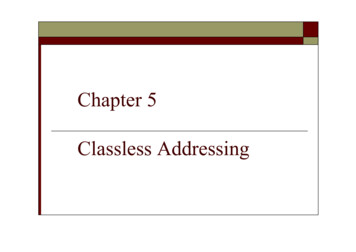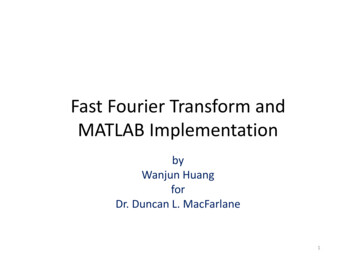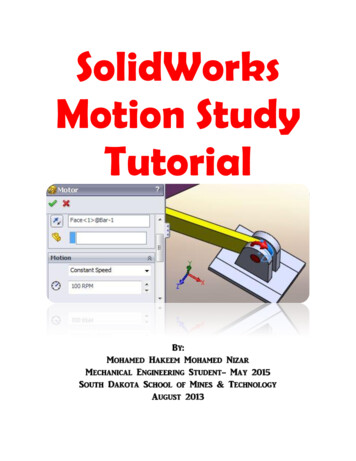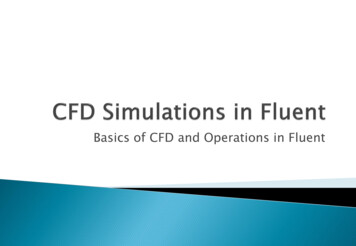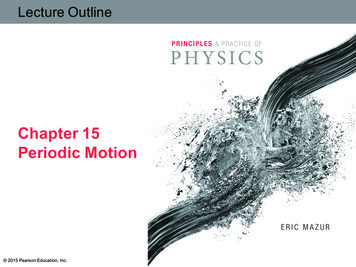
Transcription
Lecture OutlineChapter 15Periodic Motion 2015 Pearson Education, Inc.Slide 1-1
Chapter 15: Periodic MotionChapter Goal: Study the kinematic and dynamics ofperiodic motion, i.e., motion that repeats itself atregular intervals. 2015 Pearson Education, Inc.Slide 1-2
Chapter 15 PreviewLooking Ahead: Fundamental characteristics of periodicmotion Periodic motion is common at all length scales in theuniverse: On the atomic level atoms and molecules vibratein solids. At the human level macroscopic objects, such asguitar strings, vibrate On the cosmological level the universe itself has arepeating pattern of expansion and contraction. 2015 Pearson Education, Inc.Slide 1-3
Chapter 15 PreviewLooking Ahead: Fundamental characteristics of periodicmotion Periodic motion is any motion that repeats itself atregular time intervals. Oscillation (or vibration) isback-and-forth periodic motion. The period T is the minimum time interval in whichperiodic motion repeats, and the amplitude A of themotion is the magnitude of the maximumdisplacement of the moving object from itsequilibrium position. You will learn about the characteristics of periodicmotion and the physical variables used to studyperiodic motion. 2015 Pearson Education, Inc.Slide 1-4
Chapter 15 PreviewLooking Ahead: Simple harmonic motion Simple harmonic motion is periodic motion inwhich the displacement of a system from itsequilibrium position varies sinusoidally with time. Asystem moving in this way is called a simpleharmonic oscillator. A restoring force that is linearly proportional todisplacement tends to return a simple harmonicoscillator to its equilibrium position. For smalldisplacements, restoring forces are generallyproportional to the displacement and therefore causeobjects to execute simple harmonic motion about anystable equilibrium position. 2015 Pearson Education, Inc.Slide 1-5
Chapter 15 PreviewLooking Ahead: Simple harmonic motion A phasor is a rotating arrow whose component on avertical axis traces out simple harmonic motion. Thereference circle is the circle traced out by the tip ofthe phasor, and the length of the phasor is equal to theamplitude A of the simple harmonic motion. You will learn to represent simple harmonic motionboth diagramatically and mathematically. 2015 Pearson Education, Inc.Slide 1-6
Chapter 15 PreviewLooking Ahead: Fourier series Fourier’s theorem says that any periodic functionwith period T can be written as a sum of sinusoidalsimple harmonic functions of frequency fn n/T,where n is an integer. The n 1 term is thefundamental frequency or first harmonic, and theother components are higher harmonics. You will learn how to apply Fourier’s theorem toanalyze the harmonic content of periodic motion. 2015 Pearson Education, Inc.Slide 1-7
Chapter 15 PreviewLooking Ahead: Rotational oscillations A horizontal disk suspended at its center by a thinfiber forms a type of torsional oscillator. A pendulum is any object that swings about a pivot.A simple pendulum consists of a small object(the bob) attached to a very light wire or rod. You will learn how to model the motion of torsionaloscillators and simple pendulums mathematically. 2015 Pearson Education, Inc.Slide 1-8
Chapter 15 PreviewLooking Ahead: Damped oscillations In damped oscillation, the amplitude decreases overtime due to energy dissipation. The cause of thedissipation is a damping force due to friction, airdrag, or water drag. A damped oscillator that has a large quality factor Qkeeps oscillating for many periods. You will learn how to model the motion of dampedoscillators mathematically. 2015 Pearson Education, Inc.Slide 1-9
Chapter 15 PreviewLooking Back: Kinematics The non-uniform motion of an object can bedescribed by the concept of acceleration. In Chapter 3 you learned how to describe accelerationboth graphically and mathematically. 2015 Pearson Education, Inc.Slide 1-10
Chapter 15 PreviewLooking Back: Force and motion The vector sum of the forces exerted on an object isequal to the acceleration of the object. The equation of motion for an object relates theobject’s acceleration to the vector sum of the forcesexerted on it. Newton’s laws of motion describe the effects forceshave on the motion of objects. In Chapter 8 you learned how to relate force andmotion using Newton’s laws. 2015 Pearson Education, Inc.Slide 1-11
Chapter 15 PreviewLooking Back: Conservation of energy The law of conservation of energy states that energycan be transferred from one object to another orconverted from one form to another, but it cannot becreated or destroyed. In Chapter 5 you learned how to identify the types ofenergy a system has and how to represent the law ofconservation of energy mathematically. 2015 Pearson Education, Inc.Slide 1-12
Chapter 15 PreviewLooking Back: Angular velocity During rotational motion, all the particles in anobject follow circular paths around the axis ofrotation. The rotational velocity ωϑ of an object is the rate atwhich the object’s rotational coordinate ϑ changes. The rotational acceleration αϑ is the rate at which anobject’s rotational velocity changes. In Chapter 11 you learned how represent rotationalkinematics using diagrams and mathematics. 2015 Pearson Education, Inc.Slide 1-13
Chapter 15 PreviewLooking Back: Friction When two surfaces touch each other, The component of the contact force normal to thesurface is called the normal force. The component tangential to the surface is calledthe friction force. In Chapter 10, you learned that when surfaces are notmoving relative to each other, you have static friction,and when they are moving you have kinetic friction. In Chapter 10 you learned how to quantitativelyanalyze systems experiencing friction. 2015 Pearson Education, Inc.Slide 1-14
Chapter 15 Periodic MotionConcepts 2015 Pearson Education, Inc.Slide 1-15
Section 15.1: Periodic motion and energySection GoalsYou will learn to Define the concepts of periodic motion, vibration,and oscillation. Establish that in a closed system, periodic motion ischaracterized by the continuous conversion betweenpotential energy and kinetic energy. 2015 Pearson Education, Inc.Slide 1-16
Section 15.1: Periodic motion and energy Any motion that repeats itself atregular time intervals is calledperiodic motion. The figure shows the periodicmotion of a spring-cart system. What forces are present duringthe oscillation? What must be true for thesystem to oscillate? 2015 Pearson Education, Inc.Slide 1-17
Section 15.1: Periodic motion and energy The time interval it takes tocomplete a full cycle of themotion is the period T. The inverse of the period iscalled the frequency.f 1/T The object’s maximumdisplacement from theequilibrium position iscalled the amplitude A. 2015 Pearson Education, Inc.Slide 1-18
Section 15.1: Periodic motion and energy In practice, periodic motionin mechanical systems willdie out due to energydissipation. If we ignore these dampingeffects, we find that Periodic motion ischaracterized by acontinuous conversionbetween potential andkinetic energy in aclosed system. 2015 Pearson Education, Inc.Slide 1-19
Section 15.1: Periodic motion and energy The figure shows examples of oscillating systems. 2015 Pearson Education, Inc.Slide 1-20
Checkpoint 15.3For each system in Figure 15.3, identify (a) the restoringforce and (b) the type of potential energy associated with themotion.15.3 2015 Pearson Education, Inc.Slide 1-21
Checkpoint 15.3(a) Tangential portion of gravitational force; gravitational potential(b) Vertical component of elastic force in the ruler; elastic potential(c) Tangential component of gravitational force; gravitational potential(d) Vertical component of elastic force in string; elastic potential 2015 Pearson Education, Inc.Slide 1-22
Section 15.1Question 1An object hangs motionless from a spring. When theobject is pulled down, the sum of the elastic potentialenergy of the spring and the gravitational potentialenergy of the object and Earth1. increases.2. stays the same.3. decreases. 2015 Pearson Education, Inc.Slide 1-23
Section 15.1Question 1An object hangs motionless from a spring. When theobject is pulled down, the sum of the elastic potentialenergy of the spring and the gravitational potentialenergy of the object and Earth1. increases.2. stays the same.3. decreases. 2015 Pearson Education, Inc.Slide 1-24
Section 15.2: Simple harmonic motionSection GoalsYou will learn to Define simple harmonic motion and represent itgraphically. Understand the physical characteristics of therestoring force that is responsible for simpleharmonic motions. 2015 Pearson Education, Inc.Slide 1-25
Section 15.2: Simple harmonic motion Investigation of oscillating systems reveal that, whenthe amplitude is not too large, the period isindependent of the amplitude. An oscillating system that exhibits this property iscalled isochronous. 2015 Pearson Education, Inc.Slide 1-26
Section 15.2: Simple harmonic motion The x(t) curve of an isochronous oscillation are sinusoidal. Periodic motion that yields a sinusoidal x(t) curve is called a simpleharmonic motion (SHM): A object executing simple harmonic motion is subject to alinear restoring force that tends to return the object to itsequilibrium position and is linearly proportional to theobject’s displacement from its equilibrium position. 2015 Pearson Education, Inc.Slide 1-27
Section 15.2: Simple harmonic motion Simple harmonic motion is closely related to circular motion. The figure shows the shadow of a ball projected onto a screen. As the ball moves in circular motion with constant rotationalspeed ω, the shadow moves with simple harmonic motion. The ball sweeps out at an angle φ ω t in time t. Then the position of the ball’s shadow is described by Asin(ω t),where A is the radius of the circle. 2015 Pearson Education, Inc.Slide 1-28
Section 15.2: Simple harmonic motion As illustrated in the figure, the correspondencebetween circular motion and simple harmonic motioncan be demonstrated experimentally. 2015 Pearson Education, Inc.https://www.youtube.com/watch?v 9r0HexjGRE4Slide 1-29
Section 15.2Question 2A mass attached to a spring oscillates back and forth as indicated inthe position vs. time plot below. At point P, the mass has1.2.3.4.5.6.7.positive velocity and positive acceleration.positive velocity and negative acceleration.positive velocity and zero acceleration.negative velocity and positive acceleration.negative velocity and negative acceleration.negative velocity and zero acceleration.zero velocity but is accelerating (positively or negatively). 2015 Pearson Education, Inc.Slide 1-30
Section 15.2Question 2A mass attached to a spring oscillates back and forth as indicated inthe position vs. time plot below. At point P, the mass has1.2.3.4.5.6.7.positive velocity and positive acceleration.positive velocity and negative acceleration.positive velocity and zero acceleration.negative velocity and positive acceleration.negative velocity and negative acceleration.negative velocity and zero acceleration.zero velocity but is accelerating (positively or negatively). 2015 Pearson Education, Inc.Slide 1-31
Section 15.4: Restoring forces in simpleharmonic motionSection GoalsYou will learn to Correlate the restoring force and the resultingmotion of a simple harmonic oscillator. Relate the period of simple harmonic oscillations tothe magnitude of the restoring force. Establish that the period of a simple pendulum isindependent of the mass of the pendulum. 2015 Pearson Education, Inc.Slide 1-32
Section 15.4: Restoring forces in simpleharmonic motion Periodic motion requires arestoring force that tends toreturn the object to theequilibrium position. A consequence of therestoring force about a stableequilibrium position is In the absence offriction, a smalldisplacement of a systemfrom a position of stableequilibrium causes thesystem to oscillate. 2015 Pearson Education, Inc.Slide 1-33
Section 15.4: Restoring forces in simpleharmonic motion As illustrated in the figure: For sufficiently smalldisplacements away fromthe equilibrium positionx0, restoring forces arealways linearlyproportional to thedisplacement. Consequently, for smalldisplacements, objectsexecute simple harmonicmotion about a stableequilibrium position. 2015 Pearson Education, Inc.Slide 1-34
Section 15.4: Restoring forces in simpleharmonic motion The figure illustrates the cause for the restoring forcefor a taut string displaced from its equilibriumposition. 2015 Pearson Education, Inc.Slide 1-35
Section 15.4: Restoring forces in simpleharmonic motion The restoring force for asimple pendulum isprovided by the componentof the gravitational forceperpendicular to the string. From the free-body diagramwe can see that themagnitude of the restoringforce on the bob ismg sinϑ (mg)(x/ℓ) (mg/ℓ)x 2015 Pearson Education, Inc.Slide 1-36
Section 15.4: Restoring forces in simpleharmonic motionExample 15.1 Displaced stringShow that for smalldisplacements the restoringforce exerted on part 2 of thedisplaced string in Figure 15.14is linearly proportional to thedisplacement of that part fromits equilibrium position. 2015 Pearson Education, Inc.Slide 1-37
Section 15.4: Restoring forces in simpleharmonic motionExample 15.1 Displaced string (cont.)❶ GETTING STARTED Figure 15.14cshows the forces exerted by parts 1 and 3on part 2 when the string is displacedfrom its equilibrium position. I’ll assumethat these forces are much greater thanthe force of gravity exerted on part 2 sothat I can ignore gravity in this problem.The force that pulls the string away fromthe equilibrium position is not shown,which means the string has been releasedafter being pulled away from theequilibrium position. 2015 Pearson Education, Inc.Slide 1-38
Section 15.4: Restoring forces in simpleharmonic motionExample 15.1 Displaced string (cont.)❶ GETTING STARTED I begin by making a free-body diagramand choosing c a set ofc axes (Figure 15.17). The x components ofthe forces F12 and F32 cancel; the sum of the y components is therestoring force. The magnitude of the y components c isc determinedby the angle θ between the x axis and either F or F .1232 2015 Pearson Education, Inc.Slide 1-39
Section 15.4: Restoring forces in simpleharmonic motionExample 15.1 Displaced string (cont.)❶ GETTING STARTED I also make a sketch of the displacedstring, showing the displacement Δy of part 2 from its equilibriumposition. I denote the length of the string in its equilibriumposition by ℓ and the length of the displaced string by ℓ'. 2015 Pearson Education, Inc.Slide 1-40
Section 15.4: Restoring forces in simpleharmonic motionExample 15.1 Displaced string (cont.) c c❷ DEVISE PLAN The forces F12 and F32 are equal inmagnitude and their y components are determined bysin θ, which is equal to Δy / ( 12 '). If the displacement issmall, I can assume that the length of the string doesn’tchange much from itsvalue, so that ℓ ℓ'. c equilibrium cBecause the forces F12 and F32 are proportional to thetension in the string, I can also consider these forces tobe constant. Using this information, I can express therestoring force in terms of the displacement Δy. 2015 Pearson Education, Inc.Slide 1-41
Section 15.4: Restoring forces in simpleharmonic motionExample 15.1 Displaced string (cont.)❸ EXECUTE PLAN From my sketch I see thatthe ccccrestoring force is F12 y F32 y . Because F12 and F32 areequal in magnitude, I can write the sum of the ycomponents as 2F12c y 2F12c sin θ . I also know thatsin θ Δy ( 12 ') Δy ( 12 ). Combining these tworelationships, I obtain for the magnitude of the restoringccforce: Frestoring 2F12 y (4F12 )Δy. For smalldisplacements, the term in parentheses is constant andso the restoring force is, indeed, proportional to thedisplacement Δy. 2015 Pearson Education, Inc.Slide 1-42
Section 15.4: Restoring forces in simpleharmonic motionExample 15.1 Displaced string (cont.)❹ EVALUATE RESULT I made two assumptions toderive my answer. The first is that gravity can beignored. Indeed, taut strings tend to be straight,indicating that gravity (which would make the stringssag) doesn’t play an appreciable role. The otherassumption I made was that the length of the stringdoesn’t change much when it is displaced from itsequilibrium position. This assumption is also justifiedbecause the displacement of a string tends to be severalorders of magnitude smaller than the string length. 2015 Pearson Education, Inc.Slide 1-43
Section 15.4: Restoring forces in simpleharmonic motion Another way to look at oscillations is to say Oscillations arise from interplay between inertiaand a restoring force. Using this interplay between inertia and a restoringforce we can predict that The period of an oscillating object increases whenits mass is increased and decreases when themagnitude of the restoring force is increased. However, this relation does not hold for pendulums: The period of a pendulum is independent of themass of the pendulum. 2015 Pearson Education, Inc.Slide 1-44
Section 15.4Question 4A child and an adult are on adjacent swings at theplayground. Is the adult able to swing in synchronywith the child?1. No, this is impossible because the inertia of thetwo are different.2. Yes, as long as the lengths of the two swings areadjusted.3. Yes, as long as the lengths of the swings are thesame. 2015 Pearson Education, Inc.Slide 1-45
Section 15.4Question 4A child and an adult are on adjacent swings at theplayground. Is the adult able to swing in synchronywith the child?1. No, this is impossible because the inertia of thetwo are different.2. Yes, as long as the lengths of the two swings areadjusted.3. Yes, as long as the lengths of the swings are thesame. 2015 Pearson Education, Inc.Slide 1-46
Chapter 15: Periodic MotionQuantitative Tools 2015 Pearson Education, Inc.Slide 1-47
Section 15.5: Energy of a simple harmonicoscillatorSection GoalsYou will learn to Represent the motion of a simple harmonic oscillatorusing the reference circle and phasor diagrams. Derive the kinematic, dynamic, and energyrelationships for simple harmonic oscillatorsmathematically. 2015 Pearson Education, Inc.Slide 1-48
Section 15.5: Energy of a simple harmonicoscillator A phasor is a rotating arrow whose tip traces a circlecalled the reference circle. As the phasor rotates counterclockwise at a constantrotational speed ω, its vertical component variessinusoidally and therefore describe a simple harmonicmotion. 2015 Pearson Education, Inc.Slide 1-49
Section 15.5: Energy of a simple harmonicoscillator If the phasor completes one revolution in a period T,thenΔϑ 2πω ΔtT And the frequency of the corresponding SHM is1f T The SI units of f are 1 Hz 1 s–1. Combining the previous two equations we getω 2πf ω is often referred to as the angular frequency andhas the same unit (s–1) as frequency (think: rad/sec) 2015 Pearson Education, Inc.Slide 1-50
Section 15.5: Energy of a simple harmonicoscillator The rotational position of the tip of the phasor is called the phaseof the motion and is given by φ(t) ωt φi. Then, the vertical component of the phasor can be written asx(t) A sin φ(t) A sin(ωt φi) (simple harmonic motion) A is the amplitude of the phasor and φi is phase at t 0 s. Means there are 2 boundary conditions: amplitude & initial phase 2015 Pearson Education, Inc.Slide 1-51
Section 15.5: Energy of a simple harmonicoscillator Now, we can obtain the velocity and acceleration of theharmonic oscillator:dxυx ω A cos(ω t φi ) (simple harmonic motion)dtd 2xax 2 ω 2 A sin(ω t φi ) (simple harmonic motion)dt Comparing equations for x(t) and a(t), we can writeax –ω2x (simple harmonic motion) Using Newton’s 2nd law, ΣFx max , another constraint!2ΣFx mω x (simple harmonic motion) 2015 Pearson Education, Inc.Slide 1-52
Section 15.5: Energy of a simple harmonicoscillator The work done by the forces exerted on the harmonicoscillator as it moves from the equilibrium position toward thepositive x direction isxxx0x0W Fx (x) dx mω 2 x dx This work causes a change in kinetic energy, given byΔK mω2 xx0xdx mω 2 [ 12 x 2 ]xx 12 mω 2 x02 12 mω 2 x 20 For a closed system ΔE ΔK ΔU 0, which gives usΔU U (x) U (x0 ) 12 mω 2 x 2 12 mω 2 x02 2015 Pearson Education, Inc.Slide 1-53
Section 15.5: Energy of a simple harmonicoscillator If we let U(x0) 0 (a free choice), thenE K U 12 mυ 2 12 mω 2 x 2 Using expressions for x(t) and υ(t), we getE 12 mω 2 A2 cos 2 (ω t φi ) 12 mω 2 A2 sin 2 (ω t φi ) mω A1222(simple harmonic motion) Total energy determined by amplitude and frequency 2015 Pearson Education, Inc.Slide 1-54
Section 15.5Question 5If you know the initial position of an oscillator, whatelse do you need to know in order to determine theinitial phase of the oscillation? Answer all that apply.1.2.3.4.5.The massThe spring constantThe initial velocityThe angular frequencyThe amplitude 2015 Pearson Education, Inc.Slide 1-55
Section 15.5Question 5If you know the initial position of an oscillator, whatelse do you need to know in order to determine theinitial phase of the oscillation? Answer all that apply.1.2.3.4.5.The massThe spring constantThe initial velocityThe angular frequencyThe amplitudex(t) A sin φ(t) A sin(ωt φi)If t 0, need A to get φi 2015 Pearson Education, Inc.Slide 1-56
Section 15.6: Simple harmonic motion andspringsSection GoalYou will learn to Apply the mathematical formalism of simpleharmonic motion to the case of a mass attached to aspring. 2015 Pearson Education, Inc.Slide 1-57
Section 15.6: Simple harmonic motion andsprings Consider the spring-cartsystem shown. Let x0 0. The force exerted bythe spring on the cartisFSCC x kx Using ΣFx max , wecan find the equationof motion for the carto bed 2xk x2mdt 2015 Pearson Education, Inc.Slide 1-58
Section 15.6: Simple harmonic motion andsprings Comparing the previousequation toEquation 15.10, we getkω m Therefore, the motion ofthe cart is given by k x(t ) A sin t φi m The figure shows fourdifferent solutions that satisfythe equation of motion of thespring-cart system. 2015 Pearson Education, Inc.Slide 1-59
Section 15.6: Simple harmonic motion andspringsExample 15.4 Cart stuck with spring alreadycompressedCart 1 of mass m 0.50 kg fastened to a spring of spring constantk 14 N/m is pushed 15 mm in from its equilibrium position and heldin place by a ratchet (Figure 15.27). An identical cart 2 is launched at aspeed of 0.10 m/s toward cart 1. The carts collide elastically, releasingthe ratchet and setting cart 1 in motion. 2015 Pearson Education, Inc.Slide 1-60
Section 15.6: Simple harmonic motion andspringsExample 15.4 Cart stuck with spring alreadycompressed (cont.)After the collision, cart 2 is immediately removed from the track. (a)What is the maximum compression of the spring? (b) How manyseconds elapse between the instant the carts collide and the instant thespring reaches maximum compression? 2015 Pearson Education, Inc.Slide 1-61
Section 15.6: Simple harmonic motion andspringsExample 15.4 Cart stuck with spring alreadycompressed (cont.)❶ GETTING STARTED If I ignore the effect of thespring during the collision, I can say that the elasticcollision interchanges the velocities of the two carts. Imake a sketch of the initial condition of cart 1 justbefore the collision, choosing the positive x axis to theright, the equilibrium position at x 0, and the initialdisplacement of the cart 15 mm to the left of x 0. 2015 Pearson Education, Inc.Slide 1-62
Section 15.6: Simple harmonic motion andspringsExample 15.4 Cart stuck with spring alreadycompressed (cont.)❶ GETTING STARTED I alsodraw a reference circle andsketch the oscillation resultingfrom the collision (Figure 15.28).With this choice of axis, the xcomponent of the initial velocityof cart 1 is υx,i –0.10 m/s.Given m and k, and ω 2 k/m, ω 5.3 s–1. 2015 Pearson Education, Inc.Slide 1-63
Section 15.6: Simple harmonic motion andspringsExample 15.4 Cart stuck with spring alreadycompressed (cont.)❶ GETTING STARTED In contrast to the situation in Example15.3, the initial displacement of cart 1 is not equal to theamplitude of the oscillation because the collision increases thecart’s displacement from the equilibrium position. In other words,cart 1 moves leftward immediately after the collision. It continuesmoving in this direction until the elastic restoring force buildingup in the compressing spring causes the cart to stop. Thismaximum-compression position gives the amplitude of theoscillation. 2015 Pearson Education, Inc.Slide 1-64
Section 15.6: Simple harmonic motion andspringsExample 15.4 Cart stuck with spring alreadycompressed (cont.)❷ DEVISE PLAN I can determine the value of theamplitude from the mechanical energy of the cart-springsystem, which is the sum of the initial potential energyin the spring and the initial kinetic energy of the cart.The potential energy in the spring is given by Eq. 9.23;because the equilibrium position x0 is at the origin, thisequation reduces to U spring 12 kx 2 . 2015 Pearson Education, Inc.Slide 1-65
Section 15.6: Simple harmonic motion andspringsExample 15.4 Cart stuck with spring alreadycompressed (cont.)❷ DEVISE PLAN The kinetic energy is given byK 12 mυ 2 . At the position of maximum compression, allof the mechanical energy is stored in the spring, x –A,and so Emech U spring 12 kA2 .Once I know A, I can determine the initial phasefrom Eq. 15.6. I can then use that same equation tosolve for t at the position of maximum compression,where x –A. 2015 Pearson Education, Inc.Slide 1-66
Section 15.6: Simple harmonic motion andspringsExample 15.4 Cart stuck with spring alreadycompressed (cont.)❸ EXECUTE PLAN (a) The initial kinetic andpotential energies of the cart-spring system areK 12 (0.50 kg)( 0.10 m/s)2 0.0025 J2 1.0 m U kx (14 N/m)( 15 mm) 0.0016 J 1000 mm SoEmech K U (0.0025 J) (0.0016 J) 0.0041 J.122 2015 Pearson Education, Inc.122Slide 1-67
Section 15.6: Simple harmonic motion andspringsExample 15.4 Cart stuck with spring alreadycompressed (cont.)❸ EXECUTE PLAN At the position of maximumcompression, all of this energy is stored in the spring,21and so 2 kA 0.0041 J, or with the k value given,2(0.0041 J)A 0.024 m 24 mm. 14 N/m 2015 Pearson Education, Inc.Slide 1-68
Section 15.6: Simple harmonic motion andspringsExample 15.4 Cart stuck with spring alreadycompressed (cont.)❸ EXECUTE PLAN (b) Substituting the value for Adetermined in part a and the initial condition xi –15 mmat t 0 into Eq. 15.6, I obtainx(0) A sin(0 φi) (24 mm) sin φi –15 mm 15mmsin φi 0.63 or φi sin 1 ( 0.63).24mm 2015 Pearson Education, Inc.Slide 1-69
Section 15.6: Simple harmonic motion andspringsExample 15.4 Cart stuck with spring alreadycompressed (cont.)❸ EXECUTE PLAN Two initial phases satisfy thisrelationship, φi –0.68 and φi –π 0.68 –2.5, butonly the latter gives a negative x component of thevelocity (see Eq. 15.7), as required by the initialcondition.At the first instant of maximum compression, sin(ωt φi) –1, which means ω t φi 12 π . Solving for t yieldst ( 12 π – φi)/ω [ 12 π – (–2.5)]/(5.3 s–1) 0.17 s. 2015 Pearson Education, Inc.Slide 1-70
Section 15.6: Simple harmonic motion andspringsExample 15.4 Cart stuck with spring alreadycompressed (cont.)❹ EVALUATE RESULT At 24 mm, the amplitude isgreater than the 15-mm initial displacement from theequilibrium position, as I would expect. From thereference circle part of my sketch I see that it takesabout one-eighth of a cycle to go from the position ofimpact to the position of maximum compression. 2015 Pearson Education, Inc.Slide 1-71
Section 15.6: Simple harmonic motion andspringsExample 15.4 Cart stuck with spring alreadycompressed (cont.)❹ EVALUATE RESULT From Eq. 15.1 I see that thenumber of seconds needed to complete one cycle isT 2π/ω 2π/(5.3 s–1) 1.2 s, and so the 0.17-s value Iobtained for seconds elapsed between collision andmaximum compression is indeed close to one-eighth ofa cycle. 2015 Pearson Education, Inc.Slide 1-72
Section 15.6: Simple harmonic motion andspringsExample 15.4 Cart stuck with spring alreadycompressed (cont.)❹ EVALUATE RESULT The assumption that theinfluence of the spring can be ignored during thecollision is justified because the force exerted by thespring is small relative to the force of the impact: At acompression of 15 mm, the magnitude of the forceexerted by the spring is (14 N/m)(0.015 m) 0.21 N. 2015 Pearson Education, Inc.Slide 1-73
Section 15.6: Simple harmonic motion andspringsExample 15.4 Cart stuck with spring alreadycompressed (cont.)❹ EVALUATE RESULT The force of impact is givenby the time rate of change in the cart’s momentum, Δp/Δt. The magnitude of the momentum change isΔp mΔυ (0.50 kg)(0.10 m/s) 0.050 kg m/s. If thecollision takes place in, say, 20 ms, the magnitude of theforce of impact is (0.050 kg m/s)/(0.020 s) 2.5 N,which is more than 10 times greater than the magnitudeof the force exerted by the spring. 2015 Pearson Education, Inc.Slide 1-74
Section 15.6: Simple harmonic motion andspringsExample 15.5 Vertical oscillationsA block of mass m 0.50kg is suspended from aspring of spring constantk 100 N/m. (a) How farbelow the end of therelaxed spring at x0 is theequilibrium position xeqof the suspended block(Figure 15.29a)? 2015 Pearson Education, Inc.Slide 1-75
Section 15.6: Simple harmonic motion andspringsExample
A mass attached to a spring oscillates back and forth as indicated in the position vs. time plot below. At point P, the mass has 1. positive velocity and positive acceleration. 2. positive velocity and negative acceleration. 3. positive velocity and zero acceleration. 4. negative velocity and positive acceleration.



